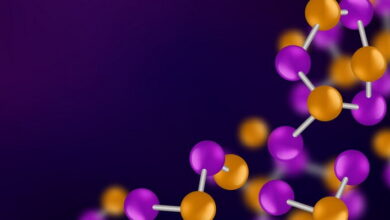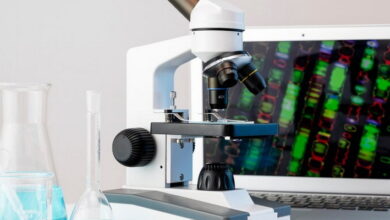Molecular Recognition MCQs with Answers

Welcome to the Molecular Recognition MCQs with Answers, it helps learners quickly identify areas for improvement in Molecular Recognition Online Test.
| Molecular recognition is a fundamental concept in chemistry and biology, where molecules interact specifically and selectively through non-covalent interactions such as hydrogen bonding, electrostatic forces, and van der Waals interactions. This process is essential for various biological functions, including enzyme-substrate binding, DNA replication, and cellular signaling, as well as applications in supramolecular chemistry and materials science.
In a molecular recognition quiz, MCQs on molecular recognition typically cover the principles governing these specific interactions. Supramolecular chemistry multiple choice questions explore the design and synthesis of host-guest systems, where a host molecule forms a complex with a guest molecule through non-covalent interactions. These questions emphasize the structural and functional aspects that influence binding affinity and selectivity. Molecular binding MCQs focus on the dynamics and thermodynamics of molecular interactions, including concepts such as binding constants, enthalpy, and entropy changes. Host-guest interactions exam questions delve into real-world applications, such as drug design, where molecular recognition is crucial for targeting specific biomolecules. Molecular recognition mechanisms MCQs examine the various factors and mechanisms that drive these interactions, including shape complementarity, electronic effects, and environmental conditions. |
Molecular Recognition Online Quiz
By presenting 3 options to choose from, Molecular Recognition Quiz which cover a wide range of topics and levels of difficulty, making them adaptable to various learning objectives and preferences. You will have to read all the given answers of Molecular Recognition Questions and Answers and click over the correct answer.
- Test Name: Molecular Recognition MCQ Quiz Practice
- Type: Quiz Test
- Total Questions: 40
- Total Marks: 40
- Time: 40 minutes
Note: Answer of the questions will change randomly each time you start the test. Practice each quiz test at least 3 times if you want to secure High Marks. Once you are finished, click the View Results button. If any answer looks wrong to you in Quiz, simply click on question and comment below that question, so that we can update the answer in the quiz section.
Download Certificate of Molecular Recognition Test
On the end of Quiz, you can download the certificate of the quiz if you got more than 70% marks.
Molecular Recognition Flashcards
What is the process by which molecules interact selectively with each other based on complementary shapes and chemical properties?
Molecular Recognition
Which type of interaction involves the specific recognition between a protein and its ligand through complementary shapes and chemical properties?
Protein-Ligand Interaction
What is the term for the recognition between two complementary nucleic acid strands through hydrogen bonding?
DNA Hybridization
Which process involves the specific recognition between an antibody and its target antigen?
Antibody-Antigen Interaction
What is the mechanism by which enzymes recognize and bind to specific substrates to catalyze chemical reactions?
Enzyme Substrate Binding
Which type of interaction involves the specific recognition between a hormone and its target receptor on a cell surface?
Hormone-Receptor Interaction
What is the process by which cells recognize and bind to specific molecules on the surface of other cells?
Cell Adhesion
Which molecular recognition process involves the specific binding of a neurotransmitter to its receptor on a neuron?
Neurotransmitter-Receptor Interaction
What is the term for the recognition between complementary sequences of nucleic acids through base pairing?
Base Pairing
Which process involves the specific recognition between a signaling molecule and its receptor on the surface of a target cell?
Ligand-Receptor Interaction
What is the mechanism by which cells recognize and bind to specific carbohydrates on the surface of other cells?
Carbohydrate Recognition
Which type of interaction involves the specific recognition between a ligand and a receptor protein on a cell membrane?
Ligand-Receptor Interaction
What is the process by which cells recognize and adhere to specific proteins in the extracellular matrix?
Integrin-Matrix Interaction
Which molecular recognition process involves the specific binding of a neurotransmitter to its receptor on a postsynaptic neuron?
Neurotransmitter-Receptor Interaction
What is the term for the recognition between complementary sequences of amino acids in protein-protein interactions?
Protein-Protein Recognition
Which process involves the specific recognition between a ligand and its target receptor in intracellular signaling pathways?
Ligand-Receptor Interaction
What is the mechanism by which cells recognize and adhere to specific molecules on the surface of pathogens?
Pathogen Recognition
Which type of interaction involves the specific recognition between a lectin protein and carbohydrate molecules on cell surfaces?
Lectin-Carbohydrate Interaction
What is the process by which cells recognize and adhere to specific molecules on the surface of neighboring cells?
Cell-Cell Recognition
Which molecular recognition process involves the specific binding of a hormone to its receptor in target tissues?
Hormone-Receptor Interaction
What is the term for the recognition between complementary sequences of RNA molecules through base pairing?
RNA Hybridization
Which process involves the specific recognition between a ligand and its target receptor in the olfactory system?
Olfactory Receptor-Ligand Interaction
What is the mechanism by which cells recognize and adhere to specific molecules on the surface of blood vessels?
Cell Adhesion
Which type of interaction involves the specific recognition between a drug molecule and its target receptor in the body?
Drug-Receptor Interaction
What is the process by which cells recognize and adhere to specific molecules on the surface of foreign particles?
Immune Recognition
Which molecular recognition process involves the specific binding of a neurotransmitter to its receptor in the synaptic cleft?
Neurotransmitter-Receptor Interaction
What is the term for the recognition between complementary sequences of DNA molecules through base pairing?
DNA Hybridization
Which process involves the specific recognition between a growth factor and its receptor on the surface of target cells?
Growth Factor-Receptor Interaction
What is the mechanism by which cells recognize and adhere to specific molecules on the surface of pathogens?
Pathogen Recognition
Which type of interaction involves the specific recognition between a cytokine and its receptor on the surface of immune cells?
Cytokine-Receptor Interaction
What is the process by which cells recognize and adhere to specific molecules on the surface of neighboring cells?
Cell-Cell Recognition
Which molecular recognition process involves the specific binding of a neurotransmitter to its receptor in the postsynaptic membrane?
Neurotransmitter-Receptor Interaction
What is the term for the recognition between complementary sequences of RNA molecules through base pairing?
RNA Hybridization
Which process involves the specific recognition between a hormone and its receptor in target tissues?
Hormone-Receptor Interaction
What is the mechanism by which cells recognize and adhere to specific molecules on the surface of blood vessels?
Cell Adhesion
Which type of interaction involves the specific recognition between a drug molecule and its target receptor in the body?
Drug-Receptor Interaction
What is the process by which cells recognize and adhere to specific molecules on the surface of foreign particles?
Immune Recognition
What is the term for the recognition between complementary sequences of DNA molecules through base pairing?
DNA Hybridization
If you are interested to enhance your knowledge regarding Physics, Computer, and Biology please click on the link of each category, you will be redirected to dedicated website for each category.




